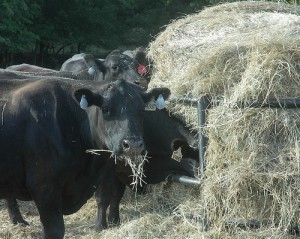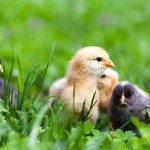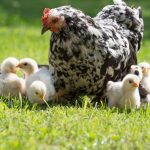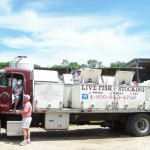Nutritive value key to overall efficiency for beef cattle intake
 COLLEGE STATION – An inexpensive hay test can offer the best guidance as to how much supplemental feed is required for a beef cattle herd, and at the same time, save ranchers money, according to a Texas AgriLife Research scientist.
COLLEGE STATION – An inexpensive hay test can offer the best guidance as to how much supplemental feed is required for a beef cattle herd, and at the same time, save ranchers money, according to a Texas AgriLife Research scientist.
Considering the historic drought conditions that prevail across Texas, Dr. Tryon Wickersham, an AgriLife Research animal nutritionist, said forage testing is even more important for cattle producers watching the bottom line.
A hay test can cost $50 or less, and many ranchers may be feeding more hay or supplement than they have to or the wrong type of supplement. A hay test will reduce the likelihood of both situations. (Texas AgriLife Research photo by Blair Fannin)
“With feeding programs being one of the most costly components of a cattle operation, every penny must be spent precisely, especially during these historic drought conditions,” Wickersham said.
A hay test can cost $50 or less, and Wickersham said many ranchers may be feeding more hay or supplement than they have to or the wrong type of supplement. A hay test will reduce the likelihood of both situations, he said, noting that his recent research evaluated both variability in crude protein content and digestibility with Bermudagrass hays.
“The outcomes were a (bit) more variable than native grasses,” he said. “The outcomes depend on how much it has been fertilized and how mature the Bermudagrass is.”
The study found that increased Bermudagrass utilization (intake and digestion) with increasing nutritive value supports the recommendation of feeding high-quality hay. “However, there must be a balance between optimizing quality, quantity and cost when producing hay,” Wickersham said. “These observations from the studies clearly demonstrate the value of purchasing and marketing hay based on nutritive value.”
Wickersham said a hay test can provide information on both crude protein content and forage digestibility, if requested.
He advised ranchers to test their hay to get a more accurate gauge as to how much supplement and what type of supplement to purchase and feed.
“Producers with higher quality hay may want to look at lower priced energy supplements and reducing hay availability as a means of conserving forage, reducing cost and maintaining body condition score,” Wickersham said. “With the current hay prices, you don’t want to give them unlimited access to hay. You don’t want to put 10 bales out and come back 10 days later.”
In contrast, Wickersham indicated that producers with lower-quality hay will need to pay attention to providing a supplement with adequate levels of both energy and protein. In either case, a producer can make a much better decision with information on hay nutritive value.
Additionally, bulk feeds can be an efficient method of feeding cow herds, but you have to have infrastructure in place to do this or evaluate the cost of adding this capacity, Wickersham said.
“Drought demands that producers find the cheapest source of energy they can realistically handle and safely feed,” he said. “Unfortunately, cheap is more than it used to be.”
Source: Blair Fannin, Media Relations Specialist with Texas A&M AgriLife Communications
October 20, 2011



